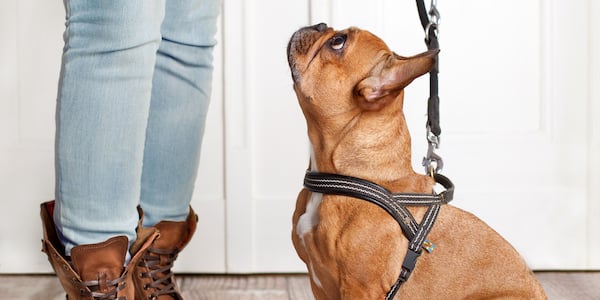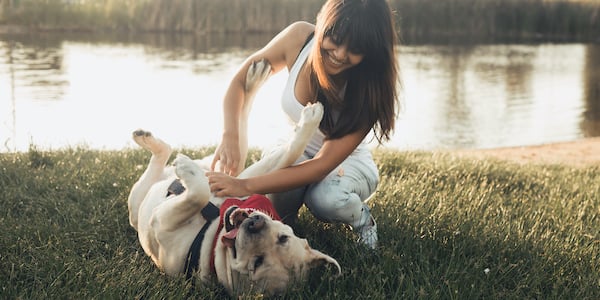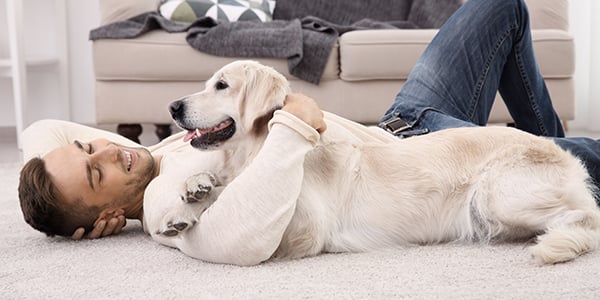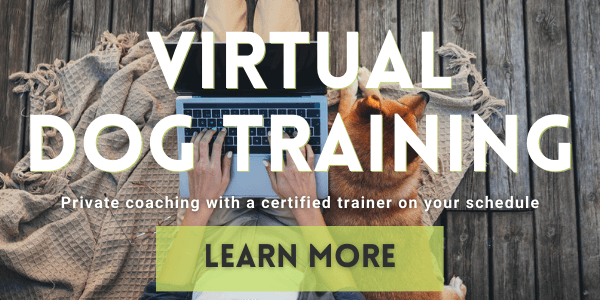 There are lots of different things that you can use instead of treats to train your dog! While dog treats are an incredibly powerful reward that motivate most dogs most of the time, you shouldn't have to rely on a piece of turkey in your pocket for your dog to listen to you.
There are lots of different things that you can use instead of treats to train your dog! While dog treats are an incredibly powerful reward that motivate most dogs most of the time, you shouldn't have to rely on a piece of turkey in your pocket for your dog to listen to you.
Real-life rewards are non-food items or activities that your dog finds enjoyable and rewarding. What your dog finds rewarding might change depending on what's going on at that moment.
Dog trainers are always asking "what does the dog want at this moment?" Then they can use that as a reward for the dog! While a lot of dogs will always take a treat, in many cases what the dog actually wants is a real-life reward.
Incorporating these types of rewards as early as possible into your dog training plan helps you in a few different ways:
-
Using real-life rewards jumpstarts the process of fading out food treat rewards.
-
Real-life rewards increase your "value" to your dog — you are the bearer of everything good and fun! This is important when building engagement and strengthening your bond.
-
You always have real-life rewards with you. This means you have a way to reward your dog for good behavior anytime and anywhere!
Different Types of Real-Life Rewards for Your Dog
Attention
Giving your dog attention is a great way to reinforce good behavior. Dogs love to be a part of whatever it is you're doing. Attention can be as simple as giving them eye contact, talking to them, and praising them.
Your body language with your dog can also be rewarding for them. Learn more about how to use body language to reward your dog in our article "How Human Body Language Can Affect Dog Behavior."
I use the reward of giving attention when teaching dogs not to jump on people. Dogs are jumping mainly to get attention (and because they're excited), and unfortunately for us humans, this usually works. We tend to shout "no," "off," "stop it," and then often touch them in our attempts to get them to stop. To the dog, this is attention — and precisely what they wanted!
If a dog jumps, remove all attention. You might even have to turn and walk back out the door. But once they stop jumping, that's the moment your attention returns. With practice, your dog will learn that jumping makes the thing they want go away, while keeping four paws on the floor means they get it.
PRO TIP: For even faster results in teaching a dog not to jump, or when working with a dog who has a long history of jumping, act preemptively. Before they have a chance to jump on you, ask them for an incompatible behavior like Sit or Down. You might need to have a treat ready to go to encourage them to focus and not jump. Set you and your dog up for success!
Touch
Some dogs adore being physically close to their people, while others find it a bit overwhelming. If your dog loves to lean on you or seeks out petting, using touch is a great option to use as a reward! From ear and chin scratches to belly rubs, try different spots out with your dog to see what kind of touch they find the most rewarding. My dog has a particular spot that she loves to have scratched just under her collar (I think because she can't reach it with her stubby Corgi legs).
Make sure your dog enjoys being touched, and avoid hugging your dog unless they enjoy it. Signs of discomfort may include: freezing, wide eyes, yawning, lip licking, or ducking their head. Check out our Decoding Dog Body Language resources to learn more about what your dog is trying to tell you.
Movement, Access, and Freedom to Explore
I use the real-life reward of getting to go through a door quite often. When my dog knows she's going for a walk, a treat is nice, sure, but what she really wants is to get outside!
To be allowed to go through the door, she has to wait at the doorway and not door dash. She must hold a stay until I release her. Or whenever I take my dog out on a sniffari, I ask for a few behaviors before releasing her to roam on her long lead.
Use your dog's motivation in each moment to your advantage and make it their reward. A common behavior that I use movement and access as a reward is loose leash walking. Dogs pull on leash for a couple of reasons, and many pull to get somewhere that smells amazing (like a fire hydrant or bush). Access to that bush and freedom to sniff it is the reward for not pulling me there.
PRO TIP: If your dog starts pulling on leash towards something, stop walking and use the name recognition cue, or another very easy cue like touch. Once they look at you, say "yes!" and run with them to the object they wanted to sniff (as long as it's safe and appropriate).

Play and Toys
Play is one of my favorite ways to connect with my dog, and getting a little goofy with your pup is a wonderful way to relieve stress. Using play and toys as training rewards is a great way to motivate dogs that aren't interested in treats, and isn't hard once you learn how to do it right. Read "How to Use Toys as Rewards in Dog Training" for tips on introducing toys and play to your dog's training.
Start using real-life rewards as soon as you can with your dog. You'll be able to fade out the use of food treats faster, and your dog will be more engaged and responsive during training. Life isn't all about food, and sharing in the other joys of life means your bond with your dog will be that much stronger.
What's your dog's favorite real-life reward? Share with us in the comments below!





